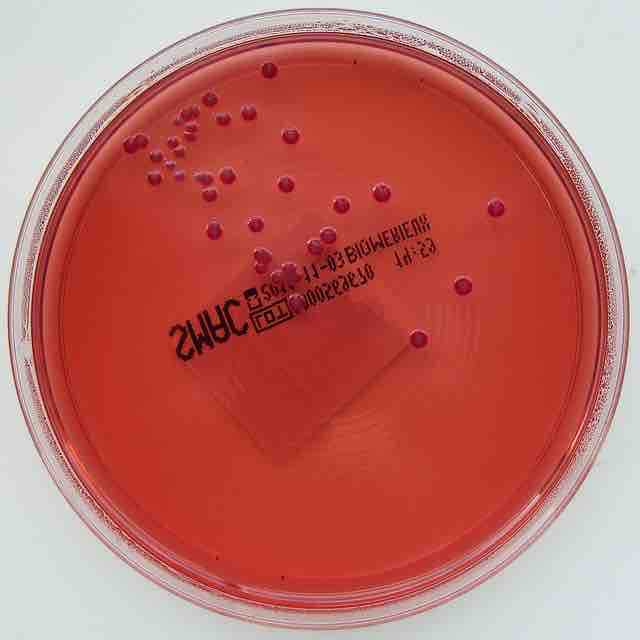Cultures and Differential Media
A microbiological culture, or microbial culture, is created using a method for multiplying microbial organisms by letting them reproduce in predetermined culture media under controlled laboratory conditions. Microbial cultures are used to determine an organism's type, its abundance in the sample being tested, or both. It is one of the primary diagnostic techniques of microbiology, where it is used as a tool to determine the cause of infectious diseases by letting the agent multiply in a predetermined medium. A throat culture, for example, is taken by scraping the lining of tissue in the back of the throat and blotting the sample into a growing medium; this will allow analysis to screen for harmful microorganisms, such as Streptococcus pyogenes, the causative agent of strep throat. The term "culture" can be used to refer to the process of culturing organisms, to the medium they're grown in, and is more generally used informally to refer to "selectively growing" a specific kind of microorganism in the lab.
Differential media, also known as indicator media, distinguish one microorganism type from another growing on the same media. These types of media use the biochemical characteristics of a microorganism grown in the presence of specific nutrients or indicators that have been added to the medium to visibly indicate the defining characteristics of a microorganism. These indicators or nutrients include but are not limited to neutral red, phenol red, eosin y, and methylene blue. Differential media are used for the detection of microorganisms and by molecular biologists to detect recombinant strains of bacteria.
Durham Cultures
The Durham tube method is used to detect production of gas by microorganisms. They are simply smaller test tubes inserted upside down in another test tube. This small tube is initially filled with the solution in which the microorganism is to be grown. If gas is produced after inoculation and incubation, a visible gas bubble will be trapped inside the small tube. The initial air gap produced when the tube is inserted upside down is lost during sterilization , usually performed at 121°C for 15 or so minutes
Escherichia coli
Escherichia coli (E. coli), a rod-shaped member of the coliform group, can be distinguished from most other coliforms by its ability to ferment lactose at 44°C in the fecal coliform test, and by its growth and color reaction on certain types of culture media. When cultured on an EMB (eosin methylene blue) plate, a positive result for E. coli is metallic green colonies on a dark purple media. Unlike the general coliform group, E. coli are almost exclusively of fecal origin and their presence is thus an effective confirmation of fecal contamination. Some strains of E. coli can cause serious illness in humans .
Sorbitol MacConkey Agar
Sorbitol MacConkey agar is a variant of the traditional MacConkey commonly used in the detection of E. coli O157:H7 . Traditionally, MacConkey agar has been used to distinguish those bacteria that ferment lactose from those that do not.

Using differential media to detect acid production
Sorbitol fermenting non pathogenic commensal bacteria from faeces growing on Cefixime Tellurite Sorbitol MacConkey Agar.
This is an important distinction. Gut bacteria, such as Escherichia coli, can typically ferment lactose; important gut pathogens including Salmonella enterica and most shigellas are unable to ferment lactose. Shigella sonnei can ferment lactose, but only after prolonged incubation; it is referred to as a late-lactose fermenter.
During fermentation of sugar, acid is formed and the pH of the medium drops, changing the color of the pH indicator. Different formulations use different indicators; neutral red is often used when culturing gut bacteria because lactose fermenters turn a deep red when this pH indicator is used. Those bacteria unable to ferment lactose, often referred to as nonlactose fermenters (NLFs) metabolize the peptone in the medium. This releases ammonia, which raises the pH of the medium. Although some authors refer to NLFs as being colorless, in reality they turn neutral red a buffish color.
E. coli O157:H7 differs from most other strains of E. coli in being unable to ferment sorbitol. In sorbitol MacConkey agar, lactose is replaced by sorbitol. Most strains of E. coli ferment sorbitol to produce acid: E. coli O157:H7 can not ferment sorbitol, so this strain uses peptone to grow. This raises the pH of the medium, allowing the O157:H7 strain to be differentiated from other E. coli strains through the action of the pH indicator in the medium.